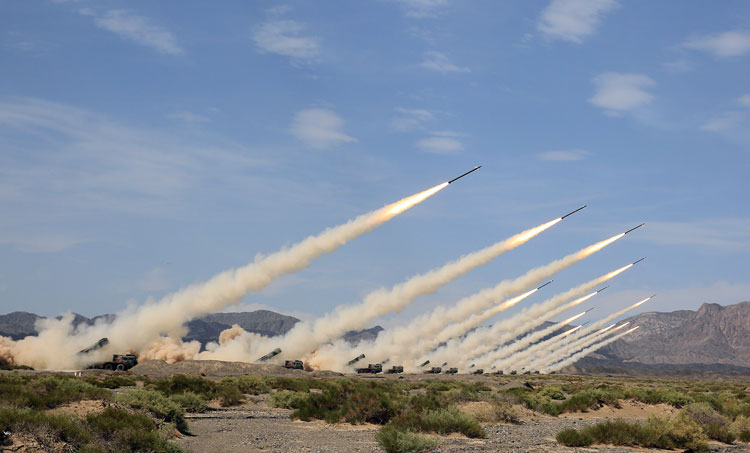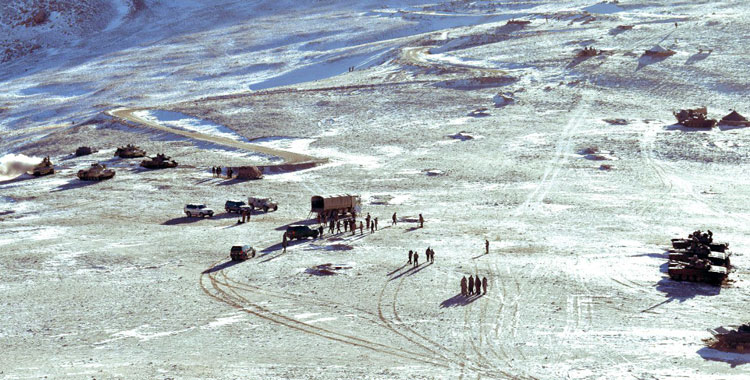INDIAN ARMED FORCES CHIEFS ON
OUR RELENTLESS AND FOCUSED PUBLISHING EFFORTS

SP Guide Publications puts forth a well compiled articulation of issues, pursuits and accomplishments of the Indian Army, over the years

I am confident that SP Guide Publications would continue to inform, inspire and influence.

My compliments to SP Guide Publications for informative and credible reportage on contemporary aerospace issues over the past six decades.
- Prime Minister witnesses 'Bharat Shakti' – a Tri-Services Firing and Manoeuvre Exercise in Pokhran, Rajasthan
- Interim Defence Budget 2024-25 — An Analysis
- Union Defence budget 2024
- Prime Minister Modi Commemorates Indian Navy Day in a Grand Ceremony
- Prime Minister Modi Flies in the LCA Tejas
- New Chapter in India-Italy Defence Ties
- Airpower beyond Boundaries
China Deploys Long Range MLRS
The MLRS will enable the PLA to strike deeper across the LAC especially with China having extended its map grids into India that will enable acquiring targets on the Indian side
 |
The Author is Former Director General of Information Systems and A Special Forces Veteran, Indian Army |

The China Daily, PLA’s official mouthpiece, reported in an article on April 19, 2021 that China has deployed a multiple rocket launcher system (MLRS) and the brigade is located 5,200m above sea level in the Xinjiang Uighur Autonomous Region (XUAR). The report did not give the type or firing range of the weapon but said it was a system with a long-range rocket with precision strike capability and had entered service in 2019.
Another publication referring to the report in China Daily wrote the move by the PLA is aimed at reinforcing China’s border defence and acting as a deterrent to India, saying, “An artillery brigade stationed 5,200 metres (17,000 feet) above sea level in Xinjiang military district has intensified its drills using a rocket system during full-wing combat-ready training.”
According to a former instructor in the PLA’s Artillery Corps, the new weapon system should be a long-range rocket launcher that can carry multiple 300mm (12-inch) or even bigger rockets with more than 100 km of firing range
Song Zhongping, a former instructor in the PLA’s Artillery Corps (predecessor of Rocket Force) told media that the new weapon system should be a long-range rocket launcher that can carry multiple 300mm (12-inch) or even bigger rockets with more than 100km of firing range. He said, “Only a long-range MLRS is powerful enough to act as a deterrent to India, as the Indian troops are also stepping up military deployment along the borders.” According to another Macau-based military observer, the long-range MLRS mentioned by China Daily was likely to be the most advanced PHL-16, or the Type PCL-191 which debuted in the National Day Parade in 2019.
China’s advanced PHL-16 (or Type PCL-191) is a truck-mounted MLRS based on the AR-2 MRL developed by Norinco. The AR-3 was marketed in 2010. The PHL-16 was unveiled during China's National Day Parade in 2019; unlike other rocket systems in the parade, the vehicles were not labeled. The vehicle is based on the 45-tonne WS2400 8x8 special wheeled vehicle chassis. The PHL-03 is loaded with fixed type of ammunition. The export version of the new MLRS, the AR-3, can switch to the 750-millimeter Fire Dragon 480 tactical ballistic missile and TL-7B anti-ship missile. However, the new PHL-16 has two modularised launch cells, which can carry different types of ammunition. Each launch cell can carry either five 300mm rockets or four 370mm rockets.
We also need to beat China in developing longer range MLRS by focusing on required research and development
Chinese MLRS fire a variety of ammunition. Unguided 300mm ammunition includes; BRC3 Cargo warhead with a range of 70 km, BRC4 Cargo warhead with 130 km range and BRE2 High Explosive warhead with 130 km range. Guided 300mm ammunition is the BRE3/FD104A (also called Fire Dragon) with a range of 130 km. Then there is guided 370mm and guided 750mm ammunitions. Guided 370mm ammunition is the BRE6/FD 200 with a range of 220 km and CEP of 30 metres. Guided 750mm is the BRE8/FD280 - 360km range for BRE8, 280 km range and 30m CEP for export version Fire Dragon 480. In addition is the TL-7B 380mm anti-ship missile unveiled first in 2017 with a range of 180 km.

The MLRS will enable the PLA to strike deeper across the LAC especially with China having extended its map grids into India that will enable acquiring targets on the Indian side. India has the Smerch 300mm rocket system with a 90 km range and the Pinaka system which too has 90 km range. In addition, the extended range version of Guided Pinaka rocket system has been developed with 100 km range using ram jet-propelled rockets. The production of these need to be ramped up on war footing and their deployment at the LAC ensured in adequate numbers. The deployment and movement of PLA’s MLRS will need to be monitored and plans made to neutralise them through fire, manned and unmanned platforms, physical action and directed energy weapons. But we also need to beat China in developing longer range MLRS by focusing on required research and development.
China has reneged from disengaging from other areas like Depsang, Gogra, Hot Springs and has pitched tents on the Indian side in Demchok
May 5, 2021 marked one year since China’s aggression and the standoff between the Indian Army and the PLA in Eastern Ladakh. China did agree to disengage on both banks of Pangong Lake because it persuaded India to forgo Delhi’s strategic advantage by vacating the Kailash Range and the heights around Chushul. But having done so, China has reneged from disengaging from other areas like Depsang, Gogra, Hot Springs and has pitched tents on the Indian side in Demchok.
Satellite imagery shows that China's winter deployment positions have been reinforced with permanent structures, accommodations and military buildings through Aksai Chin. Intelligence reports also indicate that the 10,000 permanent PLA troops positioned at Kangxiwar and Rudok have been reinforced with 10,000 additional temporary troops according to one intelligence estimate.
The depth areas of Spanggur Tso, south of the Pangong Lake have also been reinforced with permanent accommodations. Media reports citing Indian military and intelligence sources now report that China has rotated two large field formations it had deployed along the Line of Actual Control (LAC) in Ladakh in 2020 by inducting two fresh divisions in April 2021. This indicates that China has no intention of further disengagement in Eastern Ladakh and may be planning further mischief.





